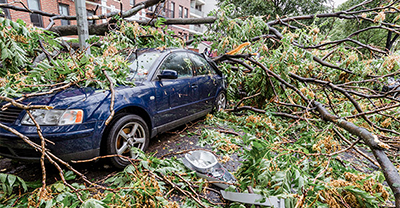Tips to manage car insurance costs and possible rate changes


0 min. read
When you're budgeting for a new car, it's easy to get caught up in thinking about your down payment and monthly payments and forget about other costs that come with owning a vehicle—including auto insurance.
In nearly every state, anyone who owns or drives a vehicle is legally required to carry auto insurance. Penalties for driving without insurance can include significant fines, suspension of driving privileges, and even having your car impounded.
Now, obviously car insurance isn’t free. So, how do you plan for the cost of insurance when budgeting? We’re here to help.
How do I plan for the average cost of car insurance?
The easiest way to estimate your car insurance costs is with an auto insurance quote from an auto insurance company. To get a quote, you’ll just need to provide a few pieces of information, such as:
Your age, driving record, and address
Type of vehicle you want to insure
Names and information for individuals who live with you and/or who will drive your vehicle
When shopping for car insurance, you’ll be able to choose the types of insurance coverages you want to help protect yourself and your car. Just keep in mind your state likely requires you to carry certain coverages—including bodily injury liability and property damage liability—while other coverages are optional.
Auto insurance policy terms
An insurance policy is a contract for a stated term, or time period. Auto insurance companies often offer monthly, six-month, and annual policy terms.
If you can afford to pay more upfront, it can help reduce your monthly payments. Alternately, you can make a lower down payment and stretch your costs out by paying in regular installments over the term of the policy to ease the strain on your budget.
Whether you pay all at once or in regular installments, as long as you make your payments on time, you avoid cancellation due to nonpayment of premium.
How can I lower my car insurance rate?
There are several ways you may be able to reduce your rates, including:
Carrying only your state minimum coverage requirements. Having fewer coverages and lower limits on your policy provides less protection than “full coverage” auto insurance—potentially leaving you vulnerable to higher out-of-pocket costs following an accident—but it can also help keep your monthly payments lower.
Maintaining continuous coverage. Whether you call it an insurance lapse or simply “taking a break from car insurance,” not having auto insurance for any period of time can make your next policy more expensive. This is largely due to the fact that most auto insurance providers view drivers with inconsistent coverage as high-risk—and more expensive to insure.
Maintaining a clean driving record. Staying accident-free and avoiding violations can help demonstrate to auto insurance companies that you’re a safe driver.
Qualify for auto insurance discounts. Most auto insurance companies offer a range of discounts to help you save even more. You may be surprised how many you qualify for. In fact, something as simple as having multiple vehicles on the same policy could earn you a discount.
What happens when my car insurance policy term ends?
Before your term of coverage comes to an end, your insurance company will decide whether to offer you another term of coverage, along with the cost for that new term. This is called a renewal offer.
You’ll have the option to accept the offer and maintain your existing policy with your current insurance company or shop for insurance from another insurer.
Reasons auto insurance premiums can change at renewal
Your renewal offer could be for the same amount as your current car insurance premiums, or it could change. Common factors that can affect your renewal offer include:
Your driving record. If your record indicates a new driving violation citation—such as a speeding ticket, DUI, or involvement in an accident—it could contribute to increased premiums.
You’ve requested a change to your policy. Common changes include adding or removing a vehicle, purchasing additional coverages, or adjusting the limits on an existing coverage.
You moved. A new address can impact your rates, since accident rates and other factors can vary by ZIP code.
Why did my insurance rates increase if nothing changed?
Sometimes your insurance rates can change even when you’re living in the same place, driving the same vehicle, and maintaining a clean driving record. Here’s why:
Vehicles are becoming more expensive to repair, in part due to increased technology in newer vehicles. Additionally, medical expenses are constantly on the rise. This means the costs associated with injuries and vehicle damages following auto claims continue to rise as well. Insurance companies need to periodically update the rates they charge to keep up with those rising costs.
That said, these rate increases don’t happen without several levels of approval. Most states require that any requested rate changes be reviewed and approved by the state’s Department of Insurance (DOI). The DOI in your state may limit how often an insurance company can request rate changes, and may even restrict the amount of allowable increase. In any case, insurance companies are required to prove the necessity of the requested changes.
Commonly asked questions on budgeting for car insurance
Why is car insurance more expensive for younger drivers?
Statistically, teen drivers are involved in a relatively high percentage of accidents compared to older drivers—largely attributed to their lack of experience. This enhanced risk can lead to higher costs for insurers, which are reflected in higher premiums for younger drivers.
Can an accident lead to increased rates, even if I wasn’t at fault?
Possibly—this depends on several factors, including the specifics of the accident and your state’s laws regarding fault.
With some knowledge about how car insurance rates are determined, you can better understand costs and stay protected on the road. Careful budgeting and shopping around helps manage the expense while maintaining essential coverage.
Does my location impact rates?
Yes. Areas with higher population density tend to have higher accident rates, which often contributes to higher auto insurance rates. Other factors can include traffic, crime rates, claim severity, and even weather.
Additionally, states with higher minimum coverage requirements often have higher rates.
The general information in this blog is for informational or entertainment purposes only. View our blog disclaimer.
*Data accuracy is subject to this article's publication date.










